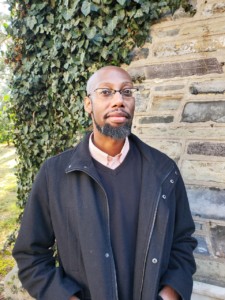PRAIRIE VIEW, Texas (June 29, 2020) – When Malachi D. Crawford, Ph.D., was growing up, he would often sit in his room, near the wall, and write in the air, occasionally turning around to explain a concept to his imaginary students. Since he’d often been kicked out of class for being disruptive, it was more than a little strange.
“My mother saw me doing this one day and looked shocked,” he said. “I was mimicking the actions of a teacher whom I actually admired. She was African American, and her name was Ms. Houston.”
Today, Crawford is an assistant professor of history in Prairie View A&M’s Marvin D. and June Samuel Brailsford College of Arts and Sciences, a role he’s held since 2018. He teaches U.S. History to 1876, U.S. History from 1876, Contemporary U.S. History and the Senior Seminar in History. His current research “examines how Africana religious communities and self-determinist movements have expanded, revised or developed new understandings of key principles within American law and Western jurisprudence.”
Crawford joined the PVAMU faculty after teaching for ten years at the University of Houston, where he was assistant director of African American Studies. As a high school student in Los Angeles, he’d known about PVAMU’s strong programs in engineering and nursing. But when Ruth Simmons became president, that really made him sit up and take notice.
“For me, it signaled the university would be making a serious investment in the humanities and social sciences, a commitment that would position the campus to emerge as a national leader in these fields. So, I applied,” he explained. “The hiring and promotion of senior faculty within my division over the last year or so, such as Drs. Melanye Price, William Hoston, William Guzman, and Michael Nojeim, have only confirmed the impression in my mind that I made the right choice.”
For Crawford, teaching offers the opportunity to not only share his knowledge and experiences, it provides a place to offer context on how historic events still carry weight today.
“I want students to have a basic understanding of the major themes and periods in American history,” he said. “It’s also important that students be able to have a clear understanding of how the basic facts associated with this history is relevant to their lives today. Especially important in today’s times, teaching reflects a process where students are encouraged to interrogate fact from fiction through their own experiences in a peaceful space. And, for me, teaching is not only about the acquisition of information or the production of bright minds, but also—in its highest form—the development of human character.”
Crawford earned his B.A. in Black studies and political science from the University of Nebraska, Omaha. He went on to earn his M.A. in 20th century U.S. history from the University of Nebraska, Lincoln. His Ph.D. in 20th century U.S. history is from the University of Missouri, Columbia, where he focused law and religion and its intersection in African American history. His first book-length manuscript, “Black Muslims & the Law: Civil Liberties from Elijah Muhammad to Muhammad Ali,” was published in 2015, part of Lexington Books’ Critical Africana Studies Series.
“The study examines the Nation of Islam’s quest for civil rights and liberties as the first sustained challenge to the suppression of African American religious freedom in American legal history,” he said. “Prior to my work, traditional narratives of the Civil Rights Movement suggested that the Nation of Islam was hostile to the concept of civil rights. The study raises basic questions about the contemporary rights of African-descended people to conceive of divine forces in their own image and on their own terms.”
Crawford is currently on research leave for his next book. And for the last two years, he has served as chair and co-chair of the Grant Proposals Committee for the Division of Social Work, Behavioral and Political Sciences.
As a teacher, Crawford admits he doesn’t use a lot of bells and whistles in his classroom.
“I deliberately try and be as plain and unassuming as possible,” he said. “In all seriousness though, it depends. I try to be flexible. I might start a class by asking students to produce an album or ‘mixed-tape’ representing the values or principles of a specific historical movement, moment, or figure. In the past, I’ve asked students to begin writing the first chapter of their biographies, using as much historical evidence about the neighborhoods and communities within which they were born as they can find. I introduce students to different archives and electronic databases that can help them find answers. If students do well on these initial assignments, I’ll introduce extra credit opportunities that expose them to historical methods. In the upper-division level courses, I ask students to produce a document or project that I think will be imperative to their success in graduate school.”
And while he loves seeing discussions about different interpretations and opinions develop in class, the best part of teaching for him is something much more meaningful.
“My favorite part of teaching is seeing students graduate,” he said. “The event causes me to reflect on my own experience and makes me tremendously proud to be an educator.”
###
By Holly Beretto

